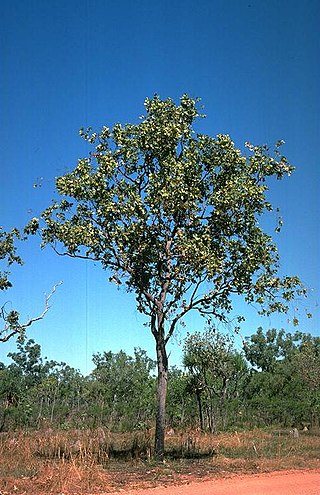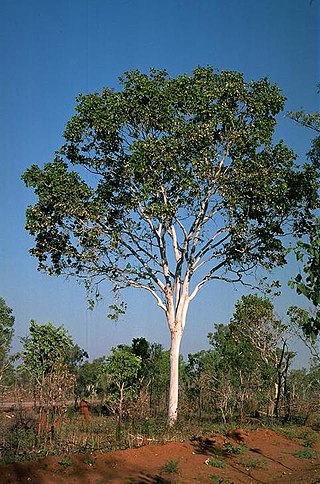
Corymbia polycarpa, also known as long-fruited bloodwood or small-flowered bloodwood, is a species of tree that is endemic to northern Australia. Indigenous Australians of different language groups have different names for the tree. The Nungali peoples know the tree as narrga or gunjid, the Mulluk-Mulluk know it as dawart, the Yangman know it as bodog, the Gurindji peoples as jadburru and the Wagiman as jagatjjin. It is a medium-sized tree with rough, tessellated bark on the trunk and branches, lance-shaped to curved adult leaves, flower buds in groups of seven or nine, white or cream-coloured flowers and barrel-shaped fruit.

Corymbia terminalis, also known as tjuta, joolta, bloodwood, desert bloodwood, plains bloodwood, northern bloodwood, western bloodwood or inland bloodwood, is a species of small to medium-sized tree, rarely a mallee that is endemic to Australia. It has rough, tessellated bark on some or all of the trunk, sometimes also on the larger branches, smooth white to cream-coloured bark above, lance-shaped adult leaves, flower buds in groups of seven, white flowers and urn-shaped fruit.

Corymbia trachyphloia, commonly known as brown bloodwood, is a species of small to medium-sized tree that is endemic to eastern Australia. It has rough, tessellated bark on the trunk, often also on the larger branches, lance-shaped adult leaves, flower buds in groups of seven, white flowers and urn-shaped fruit.

Corymbia cadophora, commonly known as twinleaf bloodwood, is a species of small, straggly tree that is endemic to the Kimberley region of Western Australia. It has rough bark on the trunk and branches, a crown of sessile, egg-shaped or lance-shaped leaves joined in opposite pairs, flower buds mostly arranged in groups of seven, creamy white to pink or red flowers and urn-shaped to barrel-shaped fruit.
Corymbia deserticola is a species of straggly tree, a mallee or a shrub that is native to Western Australia and the Northern Territory. It has rough, tessellated bark on the trunk and branches, mostly sessile, heart-shaped leaves arranged in opposite pairs, flower buds in groups of seven on each branch of a peduncle, creamy yellow flowers and urn-shaped to shortened spherical fruit.

Corymbia eremaea, commonly known as mallee bloodwood, hill bloodwood and Centre Range bloodwood, is a small, mallee-like tree that is endemic to central Australia. Indigenous Australians know the plant as muur-muurpa. It has rough, evenly tessellated bark, lance-shaped leaves, oval to pear-shaped flower buds arranged on a branching peduncle and urn-shaped fruit.

Corymbia erythrophloia, commonly known as red bloodwood, variable-barked bloodwood, red-barked bloodwood or gum-topped bloodwood, is a species of tree that is endemic to Queensland. It has rough bark on the trunk and branches, egg-shaped or lance-shaped adult leaves, flower buds in groups of seven, creamy white flowers and urn-shaped to spherical fruit.

Corymbia ferruginea, commonly known as rusty bloodwood, is a species of tree that is endemic to northern Australia. It has rough, tessellated bark on the trunk and branches, a crown of sessile juvenile leaves, flower buds in groups of three or seven, pale creamy yellow flowers and urn-shaped fruit.

Corymbia foelscheana, commonly known as broad-leaved bloodwood, fan-leaved bloodwood or smooth-barked bloodwood, is a species of small tree that is endemic to northern Australia. It has thin, rough, tessellated bark on some or all of the trunk, smooth bark above, broadly egg-shaped to broadly lance- shaped adult leaves, flower buds usually in groups of seven, creamy white flowers and urn-shaped fruit.

Corymbia grandifolia, commonly known as cabbage gum, large-leaved cabbage gum and paper-fruited bloodwood, is a species of tree that is endemic to northern Australia. It has smooth bark, egg-shaped to broadly elliptic to lance-shaped adult leaves, flowers buds in groups of three or seven, creamy white flowers and cup-shaped to cylindrical fruit.

Corymbia kombolgiensis, commonly known as scarp gum or paper-fruited bloodwood, is a species of small tree that is endemic to the Northern Territory. It has smooth bark, sometimes with rough, tessellated bark near the base, linear to narrow lance-shaped adult leaves, flower buds usually in groups of seven, white flowers and cylindrical to barrel-shaped fruit.

Corymbia latifolia, commonly known as round-leaved bloodwood, round leaf bloodwood, wubam and other names in indigenous languages, is a species of tree that is endemic to northern Australia. It has thin, rough bark over part or all of the trunk, smooth bark above, triangular or broadly egg-shaped adult leaves, flower buds in groups of seven, creamy white flowers and urn-shaped fruit.

Corymbia leichhardtii, commonly known as rustyjacket, Leichhardt's rustyjacket, or yellow jacket, is a species of tree that is endemic to Queensland. It has rough, tessellated bark on the trunk and branches, lance-shaped or curved adult leaves, flower buds in groups of seven, white flowers and barrel-shaped, urn-shaped or shortened spherical fruit.
Corymbia polysciada, commonly known as apple gum, paper-fruited bloodwood or bolomin, is a species of tree that is endemic to the Top End of the Northern Territory. It has rough, tessellated bark on some or all or the trunk, smooth bark above, egg-shaped to broadly lance-shaped adult leaves, flower buds in groups of seven, creamy white flowers and cup-shaped, cylindrical or barrel-shaped from on long pedicels.
Corymbia porrecta, commonly known as grey bloodwood, is a species of small tree that is endemic to the Northern Territory. It has rough, tessellated bark on the trunk and branches, broadly lance-shaped to egg-shaped adult leaves, flower buds usually in groups of seven, creamy white flowers and urn-shaped to barrel-shaped fruit.

Corymbia setosa, commonly known as rough leaved bloodwood or desert bloodwood, is a species of small tree that is endemic to north-eastern Australia. It has rough, tessellated brown bark on the trunk and branches, a crown of juvenile, heart-shaped leaves arranged in opposite pairs, flower buds in groups of three or seven, white flowers and urn-shaped to shortened spherical fruit.
Corymbia stockeri, commonly known as blotchy bloodwood, is a species of small tree that is endemic to Cape York Peninsula in Queensland. It has rough, tessellated bark on the trunk and branches, lance-shaped adult leaves, flower buds in groups of seven, creamy white flowers and barrel-shaped to urn-shaped fruit.
Corymbia torta is a species of tree that is endemic to the Kimberley region of Western Australia. It has smooth bark, lance-shaped adult leaves, flower buds in groups of three or seven, creamy white flowers and cup-shaped, cylindrical or barrel-shaped fruit.

Corymbia watsoniana, commonly known as large-fruited yellowjacket, is a species of tree that is endemic to Queensland. It has rough, tessellated bark on the trunk and branches, egg-shaped to broadly lance-shaped adult leaves, flower buds in groups of seven, creamy white flowers and barrel-shaped or urn-shaped fruit.
Corymbia xanthope, commonly known as Glen Geddes bloodwood, is a species of tree that is endemic to a small area of Queensland. It has thick, rough bark on the trunk and branches with yellow bark visible underneath, lance-shaped to curved adult leaves, flower buds in groups of seven, creamy white flowers and urn-shaped fruit.
















